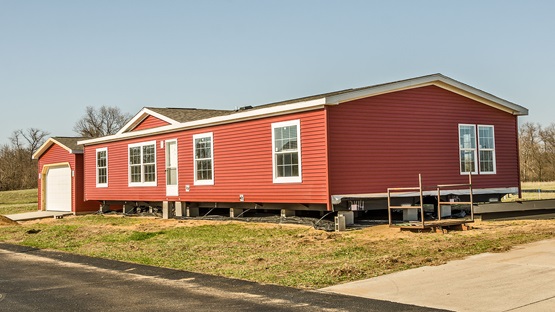While the financial security of U.S. households is frequently studied, comparatively little research focuses on the economics of American Indian and Alaska Native (AIAN) households specifically. The Center for Indian Country Development (CICD) is helping to fill this gap with new analysis of a key annual survey of American households: the Federal Reserve’s Survey of Household Economics and Decisionmaking (SHED). We find that the degree of financial security AIAN households experience is consistently lower than that of non-AIAN households. And while non-AIAN households’ financial security has been clearly improving since 2016, AIAN households’ gains have been inconsistent.1
Expanded SHED analysis focuses on AIAN respondents
Since 2013, the SHED has provided ongoing insight into how American households experience the economy. Items such as “the $400 question” are widely cited barometers for the condition of household-level financial security. SHED reports break results down by race and ethnicity, but these breakdowns have not previously shown results for AIAN households due to the small sample size of AIAN SHED respondents relative to other respondents.
Specifically, publicly available data from the SHED show that from 2014 to 2022, only 1 percent of respondents are categorized as AIAN. Contributing to this limited sample size are both the small share of the U.S. population self-identifying as Native (2.9 percent identified as AIAN on the 2020 decennial census) and the way in which race information is captured in these SHED data (and often in other datasets as well). Respondents are placed into either one of five single-race categories, including AIAN, or into a single multi-race category. However, according to U.S. census data, well over half of AIAN individuals identify as one or more other races—individuals who thus cannot be included in our analysis.
We pooled nine years of SHED data to overcome these sample-size limitations. (We excluded the first year of the SHED—2013—due to substantive differences in the wording of relevant survey items.) Through visualizations2 and analytical techniques,3 we characterized how, overall, AIAN households fared financially from 2014 to 2022, aiming to provide insight into the correlation between households’ AIAN identification and measures of financial security independent of other factors. To our knowledge, our analysis is the first to focus on the economic experiences of AIAN households reflected in SHED data.
The $400 question
How would a household pay for an emergency that costs $400? A commonly reported measure of financial security from the SHED is “the $400 question”: that is, the extent to which American households report that they would pay for a $400 emergency expense using “cash or its equivalent,” defined as paying with current cash assets or putting the expense on a credit card and paying it off at the next statement.4
AIAN households consistently report a lower likelihood of paying cash or its equivalent for a $400 emergency expense than non-AIAN households, as shown in Figure 1. Each year a larger share of non-AIAN households respond affirmatively that they would cover a $400 emergency expense with cash or its equivalent than AIAN households. Non-AIAN households reach a peak in 2021, with 68.2 percent saying yes, compared to the peak for AIAN households in 2019 at 46.5 percent. Share responding affirmatively increases generally over time for non-AIAN households, with the lowest point in 2014 at 53.2 percent; by contrast, no clear overall trend exists for AIAN households. The lowest point for AIAN households is 29.4 percent in 2015, followed closely by 30.0 percent in 2022.
The drop-off in financial security from 2021 to 2022—for AIAN and non-AIAN households alike—may have been partially driven by the expiration of large federal income transfers such as the Child Tax Credit. Consistent with that explanation, findings from the $400 question show that parents experienced especially large reductions in their financial security by this measure.
Combining all responses across 2014–2022, we find that AIAN households are 33.7 percent less likely5 than non-AIAN households to say yes to the $400 question. Incorporating differences in sex, age, renting status, employment status, retirement status, and whether a respondent reports working multiple jobs closes the gap in likelihood only modestly to 29.3 percent,6 which remains statistically significant.
Households doing okay or living comfortably
Fewer AIAN households report that they are doing at least okay financially. Figure 2 compares the share of AIAN vs. non-AIAN households that—when asked to choose which best describes how well they are managing financially these days—report “doing okay” or “living comfortably.”7
Among non-AIAN households, the trend over time in the share that reports doing at least okay financially generally resembles that of the $400 question. These households experienced their lowest point in the series, 64.9 percent, in 2014, with their highest point, 78.1 percent, in 2021. Meanwhile, AIAN households reached their highest point in 2016 at 64.7 percent (still lower than the lowest point among non-AIAN households) and lowest in 2014 at 43.5 percent.
In 2020—the peak of the COVID-19 pandemic—slightly less than half of AIAN households, 49.8 percent, reported doing at least okay financially, a sharp decline from the prior year. Notably, non-AIAN households reported no such decline in financial security. This is consistent with previous CICD findings that Indian Country was particularly economically affected by the pandemic.
In the analysis of responses across 2014 to 2022, we find that AIAN households are 20.3 percent less likely8 than non-AIAN households to report doing at least okay financially. When we consider differences in sex, age, renting status, employment status, retirement status, and whether a respondent reports working multiple jobs,9 AIAN households remain a statistically significant 16.9 percent less likely than non-AIAN households to report doing at least okay financially.
How do households feel they’re faring across time?
The widespread uncertainty of the post-pandemic economy is reflected in SHED data. Since 2014, the survey has included two questions that elicit perceptions of changes in financial security over time. One asks respondents to compare their own current financial situation to that of 12 months ago, and the other asks the respondent to compare their financial situation to that of their parents at the same age.10
Figure 3 shows the share of households that report being “somewhat” or “much” worse off than they were 12 months before. Unsurprisingly, 2020 saw sharp spikes: a 17.3 percentage point increase for AIAN households and a 10.3 percentage point increase for non-AIAN households. It might have been expected that the subsequent relaxation of COVID-19-era restrictions would lead to a gradual return to pre-pandemic perceptions of financial security, but in fact the opposite has been the case. After a brief dip in 2021, perceptions of being worse off than they were a year ago reached new peaks in 2022 for both AIAN and non-AIAN households, at 36.5 percent and 34.6 percent, respectively. This trend stands in stark contrast to those shown in figures 1 and 2, which indicate a more optimistic trajectory.
Respondents’ comparisons of their current financial situation to that of their parents showed a less stable pattern over time (data not shown). In 2020, 22.1 percent of AIAN households and 21.1 percent of non-AIAN households reported that they were “somewhat” or “much” better off financially than their parents were at their age. In 2022, these shares had risen somewhat, to 27.6 percent among AIAN households and 23.8 percent among non-AIAN households.
Combining 2014 to 2022 data, we find that AIAN respondents are modestly more likely to report being worse off than they were 12 months before compared to non-AIAN respondents, but the difference is not statistically significant.11 The addition of differences in sex, age, renting status, employment status, retirement status, and whether a respondent reports working multiple jobs to the statistical model closes the gap somewhat, but it remains statistically indistinguishable from zero. Analyses of AIAN vs. non-AIAN responses to whether they are doing better than their parents were at their age are similarly inconclusive.
Barriers to economic inclusion—and ways to address them
Even pooling across nearly a decade of SHED responses, AIAN sample size is still relatively small, which limits our ability to distinguish real differences from natural irregularities in data. But this analysis does illuminate some of the ways that AIAN households experience the economy similarly to and differently from non-AIAN households.
Overall, the SHED story for AIAN households is mixed. The shares of AIAN and non-AIAN households that report doing at least okay financially and that say they would pay for a $400 emergency expense with cash or its equivalent are higher today than in 2014. However, as compared to non-AIAN households, AIAN households have been less likely to experience either of these positive economic indicators in every year on record. Moreover, some measures of economic well-being have hit all-time lows: as of 2022, more AIAN households report being worse off than they were 12 months ago than in any prior survey year, and affirmative answers to the $400 question among AIAN households are within a percentage point of their lowest on record. Financial stress—felt acutely nationwide by many in the wake of the COVID-19 pandemic—has negative implications across areas of individual and community life ranging from the economic to the psychological. The persistently lower level of financial security among AIAN households indicates barriers to economic opportunity generally.
Numerous avenues exist to expand economic inclusion and strengthen financial security for Native American households. Despite striking gaps in household wealth and geographic challenges in access to small business support, self-employment among younger Native individuals (i.e., those under age 35) has consistently approached or exceeded the national average for the past decade. Tribal governments own and operate innovative businesses that create jobs and use revenues to help fund critical services for communities. Previous CICD research has shown that the presence of Native-focused financial institutions in Native communities can lead to increases in individual credit scores through pathways such as providing borrowers in varied circumstances with access to diverse, high-quality loan products. A business and policy landscape with improved access to these and other entry points to economic prosperity can help more Native families answer yes to the $400 question.
Endnotes
1 The SHED surveys a nationally representative sample of U.S. adults, who answer questions about themselves and their households. Because our analysis includes SHED items that contain the language “you (and the people living with you),” we use the term “household” to characterize the experiences that respondents reported. This term is interchangeable with “adult” in other SHED reporting.
2 We use an approach initially introduced by Barros and Hirakata and Zou and popularized in the public health literature that allows us to report risk ratios rather than odds ratios for our outcomes of interest. This helps make results more straightforward to interpret while maintaining rigor.
3 The variable names for survey weights in the SHED data change by year. Based on guidance from colleagues at the Board of Governors of the Federal Reserve System, we use the following weights to align with previously published SHED results: 2019–2022, weight_pop; 2018, weight2b; 2016–2017, weight3b; 2014–2015, weight3.
4 The $400 question reads, “Suppose that you have an emergency expense that costs $400. Based on your current financial situation, how would you pay for this expense?” Following the general convention used in reporting results, we categorize as affirmative responses of “With the money currently in my checking/savings account or with cash” and/or “Put it on my credit card and pay it off in full at the next statement,” with no other responses selected.
5 Simple-model risk ratio 0.663 (95 percent confidence interval: 0.538, 0.817).
6 Full-model risk ratio 0.707 (95 percent confidence interval: 0.585, 0.855).
7 The other answer choices to this question are “Just getting by” and “Finding it difficult to get by.” A secondary analysis examining the correlation between doing at least okay financially and likelihood of saying yes to the $400 question yielded inconclusive results.
8 Simple-model risk ratio 0.797 (95 percent confidence interval: 0.724, 0.877).
9 Full-model risk ratio 0.831 (95 percent confidence interval: 0.758, 0.911).
10 See SHED codebooks for wording and answer choices, which have remained substantively consistent from 2014 to 2022.
11 For the 12-month comparison item: Simple model risk ratio 1.167 (95 percent confidence interval: 0.822, 1.658); full-model risk ratio 1.102 (95 percent confidence interval: 0.795, 1.526). For the parent comparison item: Simple-model risk ratio 0.971 (95 percent confidence interval: 0.632, 1.491); full-model risk ratio 0.916 (95 percent confidence interval: 0.589, 1.425).
Vanessa Palmer is the data director for the Minneapolis Fed’s Center for Indian Country Development (CICD), where she leads efforts to collect, harmonize, and sustainably manage research-ready data in support of economic self-determination in Indian Country. In addition, she uses statistical tools and data visualization to support CICD’s applied research work.






